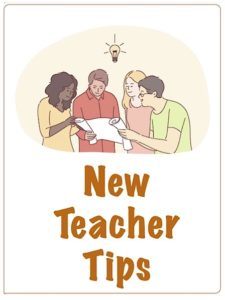Teaching Tip: Always Start with a Power Move
A MiddleWeb Blog

One thing I’ve picked up on so far is how vital it is to have a powerful start. A wrestler who comes out quick, gains offensive control, and scores points early in the match has a high likelihood of success. Conversely, a sluggish start results in a fatiguing, uphill battle to regain control and survive the round.
As I’ve worked with new teachers this past year, I’ve observed a similar phenomenon. The opening minutes of a lesson are crucial. How we begin class is the key to enlivening – or extinguishing – student interest and learning.
Previewing Strategies
Effective learning begins when we help students make connections between what they already know and what will be learned. Research shows that this “previewing” helps improve student learning, especially for students with limited background knowledge (Bloom, 1976; Hattie, 1992; Marzano, 2019). Examples of previewing strategies that can serve as power moves include:
► Bait and switch. Here’s a fun way to help students identify misinformation and misconceptions in what will be taught. Teachers start by identifying common misconceptions that students might have about a topic to be studied, such as the ocean. Then the teacher administers a True/False quiz with statements that all seem plausible but are all false. The teacher reveals to students that ALL the statements are inaccurate but are commonly misunderstood, and invites students to learn more about each one of misconceptions throughout the lesson.
► Informational hooks. These are activities designed to pique student interest in the concepts/skills to be learned. Teachers can utilize short, relevant video/audio clips, news headlines, images, and other attention grabbing media. Anecdotes and personal stories related to the lesson can also be used.
I was recently in a class where a new teacher was starting off an SEL lesson on personal/collective goals. She began with an image and story of herself in a high school, during a cross-country race, grimacing at the finish line. Her students – who are usually difficult and disengaged – were mesmerized and intrigued.
When developing informational hooks, teachers should consider questions such as…
• What concepts/skills am I helping students to master?
• What is truly unique, novel, useful, etc. about what will be taught?
• What media or anecdotes are most likely to pique students’ interests without distracting from what will actually be taught/learned?
► Vocabulary splashes. We often need a way to help students preview important terms and concepts for a lesson. Using this strategy, the teacher presents students with the most crucial vocabulary/terms for the lesson and a clear, concise explanation of each word. Students then try to sort the terms into categories that make sense to them.
After the sort students ask classmates to share their categories and the reasoning behind them. The teacher then runs a class discussion of how the terms and concepts are related to each other…and to learners’ interests and prior knowledge. At the end of the lesson, students sort/explain the vocabulary terms again.
Dive-in Strategies
As the name implies, a dive-in strategy is a task students engage in immediately, rather than easing into the topic/skills being taught. Our power move here is to get students’ brains firing, wondering, reviewing, and practicing. Here are four dive-in moves I recommend to my teacher ed students.
► Rapid review is a way for teachers to help students build confidence and mastery in a safe, supportive environment. The teacher asks students to retrieve from memory what they recently learned about a certain topic, partner with a classmate to discuss this topic, and then present. (Here’s an video example.) This approach gets students active and helps the teacher know what actually “stuck” from the previous day’s lesson.
► Quick quizzes can be an effective tool for starting a lesson, stirring up background knowledge, and getting students actively participating. Questions should be simple in format, not include too many answers, avoid trick questions, and be followed up with feedback. Oftentimes, administering a quick quiz via a tech tool like Kahoot, Google Forms, GradeCam, Plickers, Classtime, Edulastic, Formative or Ziplet can add a bit of novelty, fun, and take the “ew” out of review.
► Interactive maps and visual data are effective tools for tapping into students’ affect, or cognitive/emotional investiture, in a lesson. Teachers work to find a relevant, fascinating visual display of information and have students either (a) guess and justify what information is being discussed or (b) answer a series of questions based on the information being displayed.
Some of my favorite sources for attention-getting imagery include visual journalism graphics from The New York Times, graphics from articles I’m reading, and interesting maps from Far and Wide. There’s also this feature from the NYT Learning Network – What’s Going On in This Picture.
► Surveying students prior to a lesson allows teachers to introduce a topic, gauge interest, and check for existing knowledge about a topic. Google Forms, for example, allow teachers to send quick polls to students about subjects such as banned books, capital punishment, school safety, and even UFO’s, then display the results in real time in graphic form for students to see/discuss. Teachers then ask each student to work individually to examine the tabulated results and answer questions such as…
• What patterns or trends do you notice?
• When you look at the data, what catches your attention or surprises you?
• In what ways are your responses similar to that of the rest of the class?
• In what ways are your responses dissimilar to that of the rest of the class?
Students win when we have strong starts
Just like a wrestling match, teachers – and students – need to get off to a strong start. How we begin class can make all the difference in a lesson.
The battle against student disengagement and disinterest is winnable when we work to infuse the opening minutes with experiences designed to pique student interest, activate prior knowledge, have some fun, and prepare them for the day’s learning.
Edutopia republished portions of this article.






































Great advice, Curtis, for both beginning and veteran teachers! I often use the precise educational terminology for presenting discrepant events — I call it “Messing with kids’ heads.” Kidding. The point is that it’s a fun way to get kids’ attention and inspire them to take a deeper look at things. Thanks for sharing these specific techniques to engage learners.